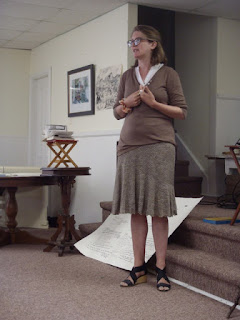Bishop’s letter of 5 July 1956 contains an addendum dated 16
July. The first part got “mislaid” and she went to Rio
for several days. The letter turned up again in her studio at Samambaia and
Bishop finished and mailed it, with a cheque for $15, for the maple syrup Grace
was commissioned to obtain and send (an amount which Bishop hoped would cover
the postage — these days, that amount wouldn’t even cover a fraction of the
postage!)
In the initial part of the letter, Bishop had updated Grace
about her boils, giving her aunt an account of how they came to manifest. She
had “an infected gum, first,” which infection decided to move to her knee,
where erupted enough boils that walking was not possible. As always, Lota’s
“tender care” kicked in and that with the help of “Antiphlogistine” and vitamin
B, she began to feel better quickly, even though the boils persisted: “God
knows what it is.” She noted that she would see a doctor in Rio
about this situation, “as soon as I can.”
That consultation happened while she was visiting Rio in the days between 5 and 16 July, so Bishop was able
to provide a second update in the same letter. As it turned out, the boils were
“a bad reaction to penicillen” [sic]
which she had taken for the gum infection (three shots of it). “Fortunately,”
she noted, “I take metacorten [sic]
all the time anyway, for asthma, and that’s just what I should have taken.”
Once the penicillin was out of her system, the boils turned to red lumps, then
to bruises.
chemical formula for penicillin
“When someone is allergic like me, you never know what may
happen, apparently,” she wrote to Grace, who understood well enough these
causations. Just like the “ghastly” plane crashes she wrote about, Bishop
observed what we all know (and even more so today, with even more reason), “These
new drugs are fearful & wonderful, aren’t they.”
To further reassure Grace, Bishop noted that she had a good
allergy doctor, “the best in Rio, a young man,
a friend of a friend, and he won’t take a cent.” Even as Bishop argued with him
about this generosity, he would not relent, so she told Grace that she’d now
have to figure out some sort of present to give him. Stay tuned. Her next
letter reveals what gift she chose, and I will let you know when we get there.
Fast forward over four decades: On 2 February 1998, I gave a
talk to members of the History of Medicine Society in Halifax, Nova Scotia:
“‘In the Waiting Room’: Elizabeth Bishop’s History of Medicine.” Like finances/money,
health/medicine were foundational forces in Bishop’s life, affecting every
aspect of it. In Grace, she had a correspondent who not only cared about her
health issues, but also understood them deeply, having spent most of her early
adult life tending to the sick and injured. Doctors and hospitals were present
in Bishop’s life from the beginning and they played important roles in shaping
her world view. And her letters to her aunt contain many references to all
things medical (one of their main subjects).
Thus, it seemed logical to talk to a room full of doctors
about Bishop’s close relationship with the medical world. After all, at one
point, Bishop almost gave up poetry to become a doctor.
I don’t remember giving the talk, alas, at least not any
particulars. But I do remember the q&a was lively and the doctors were
surprised and impressed by Bishop’s knowledge of drugs and medical procedures. (If
anyone is interested in this talk, I can send a pdf — just make a comment to
the blog with your email address.)
Nova Scotia Hospital (N.S. Archives)
I puzzled for awhile over an appropriate image for this post
(how does one show “these new drugs.” But then I thought of the above image of perhaps
the most important hospital in Bishop’s life: The Nova Scotia Hospital (a.k.a. Mount Hope),
in Dartmouth, N.S., where her mother Gertrude spent 18
years of her life. If you start looking for hospitals, nurses, doctors and
other medical elements in Bishop’s poetry and prose, you find quite a
population of them, and no surprise. Medical and health issues were not just
daily things that happened to Bishop, she pulled them into her art, too, and looked
at them from all angles, transformed them into symbols, metaphors, emblems,
which resonate for us all.
St. Elizabeth's Hospital
The image above is of St. Elizabeth’s Hospital in Washington D.C.
One of Bishop’s official duties when she was Poetry Consultant at the Library
of Congress in 1949–1950 was to visit Ezra Pound, incarcerated there. Out of
those experiences came “Visits to St. Elizabeths,” a somewhat controversial
poem. What is fascinating and little known is that the woman responsible for
establishing St. Elizabeth’s Hospital, Dorothea Dix,
also played an instrumental role in the creation of the Nova Scotia Hospital.
I have written in detail about this connection in my book Lifting Yesterday. Bishop was quite aware of Dix’s involvement with
both hospitals and said to her friend Dorothee Bowie that the only biography
she ever wanted to write was about Dix because she had helped the mentally
“insane.”
The next post will be the last for the 5 July 1956 letter
and return to poor Aunt Florence and other matters.




















